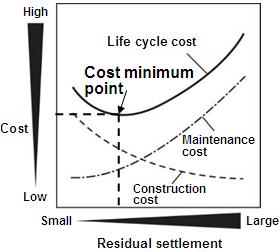Prediction of Long term Settlement of Peaty Ground
Approach to the Reduction of Life Cycle Costs of Earth Structures Built on Peaty Ground
 Fibrous peat often found in Hokkaido  Settlement of a road on peaty ground |
 Slip failure generated on an embankment under construction on peaty ground  Conceptualization of life cycle costs of roads on peaty ground |
Peat is a special type of extremely soft soil resulting from the long-term
accumulation of decayed plant matter as it remains only partially decomposed.
Civil engineering facilities on peaty ground are prone to very difficult
problems including long-term continuing major settlement and slip failure
due to extremely low load strength. At CERI, we have been conducting research
to overcome this issue since the days of CERI's predecessor, the Civil
Engineering Research Institute of the Hokkaido Regional Development Bureau,
and have already proposed settlement prediction and strength evaluation
formulae for peaty ground, which are in wide use in practical applications.
In recent years, however, even safer and more secure and economical infrastructure
development is called for and the selection of effective and efficient
countermeasure construction methods are now more important than ever for
civil engineering facilities on peaty ground as well. To this end, it is
necessary to select countermeasure construction methods in consideration
of life cycle costs, the balance between construction and maintenance costs.
In view of this background, we have developed a technique for predicting
long-term settlement capable of accurately taking into account the increase
of load due to countermeasure construction and maintenance works on peaty
ground and shown the applicability of the new construction method and technology
to peaty ground to study design and execution management methods on peaty
ground.
As a result, we have quantitatively found out that understanding life cycle
costs requires the prediction of construction and maintenance costs by
specifying in advance the amount of ground residual settlement after starting
of service. In other words, we have reconfirmed the importance of long-term
settlement prediction in peaty ground and successfully established an analysis
technique that is more accurate and widely applicable than conventional
methods. In addition, we are in the process of assessing the effects of
new countermeasure construction method on the soft ground as it is applied
to peaty ground. In the future, we plan to revise the Manual for Countermeasures
against Peaty Soft Ground so that these research results can be widely
used in practical applications.
(Contact: Geotechnical Research Team, CERI)
Guidelines for Road Tunnel Observation and Measurement Revised
Application of On-site Observation and Measurement for Safe and Economical
Tunnel Construction
The Technical Standard for Road Tunnels on mountain tunneling methods is
one of the technical standards regarding the structure of road tunnels.
The Standard specifies tunneling using supports combining materials such
as shotcrete, rock bolts, and steel arch supports as the standard method.
The Technical Standards and Explanation for Road Tunnel (for Structures)
specifically describing these standards has been published, and engineers
engaged in the design and construction of road tunnels use it as a technical
base.
For tunneling work, observation and measurement during the construction
(how it is performed is shown in Photo-1) and the uses of the results thereof
are considered important for the stability of the entire tunnel and economical
construction. This concept is also explained in the Technical Standards
(the concepts behind application of observation and measurement in tunnel
construction are shown in Figure-1). Accordingly, the Guidelines for Road
Tunnel Observation and Measurement were published in 1993 by the Japan
Road Association to facilitate the understanding of the importance of observation
and measurement by engineers and provide a reference for practical work.
After the publication of the Guidelines, the importance of observation and measurement in accurately understanding phenomena generated during tunnel construction and of applying the results to construction has been further recognized and the results of various construction works have been accumulated from the construction of many tunnels. Based on these circumstances, the Tunnel Research Team has been conducting studies related to the use of road tunnel observation and measurement results. Consequently, a revised version of the Guidelines for Road Tunnel Observation and Measurement incorporating the obtained research results was published in February 2009.
The revised Guidelines use a database of road tunnels constructed in the
past as its basis and take advantage of information such as the conditions
of rocks and cracks in them observed on the "tunnel face," that
is, the plane of tunneling end, and spring water to present the quantitative
reference for the selection of supports.
In terms of methods of exploration that allow safe and economical construction of tunnels, the description about the techniques, evaluation of results, and the concept of their application have been added to the Guidelines. Furthermore, case examples of countermeasure construction methods to address the difficulty in ensuring face stability (Photo-2) and the deformation of supports due to excessive earth pressure and an explanation of how to apply the results of observation and measurement to countermeasure construction methods have also been added.
(Contact: Tunnel Research Team)



